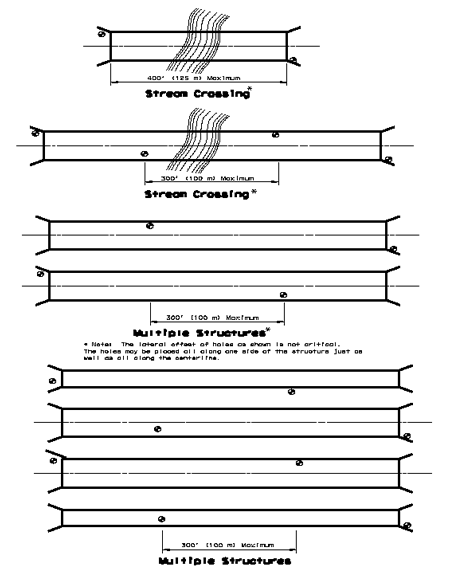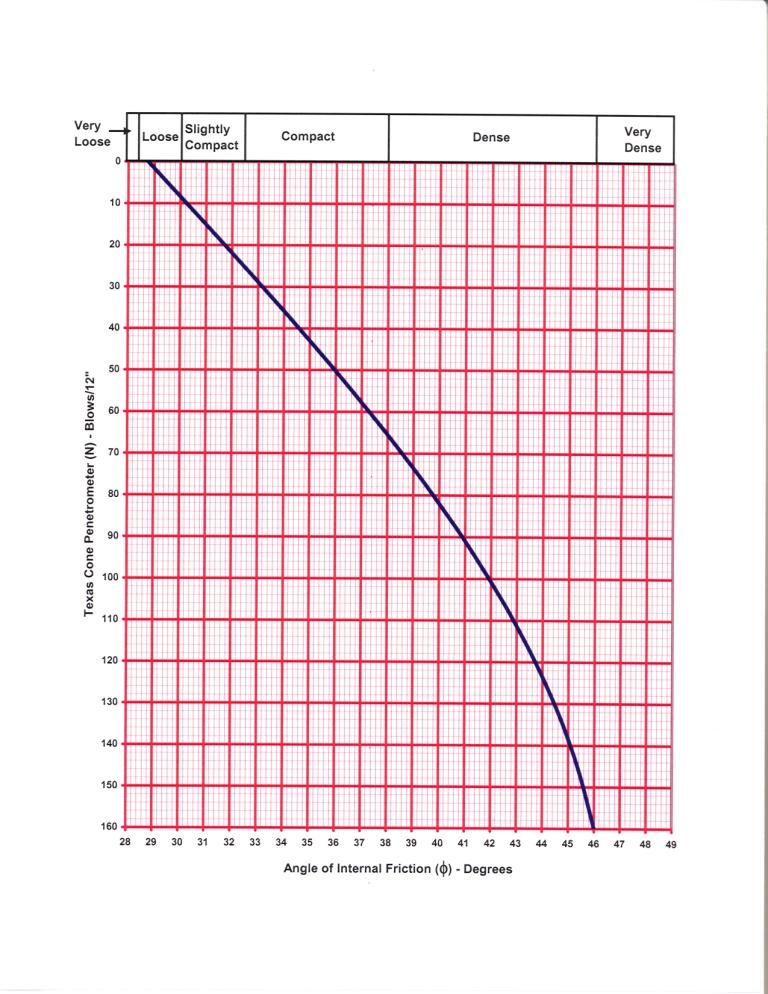Chapter 2: Soil Surveys
Anchor: #BGBHDFIGSection 1: Soil Surveys
Anchor: #i1026939Overview
Conduct soil surveys for projects with the following features:
- Anchor: #XBFRGPOI
- Bridges Anchor: #MKJHTIDE
- Retaining walls Anchor: #EVKAPQQH
- Slopes and embankments Anchor: #JXSQGSBC
- Sign structures Anchor: #XFDUGQFS
- Illumination Anchor: #JXQNMLNO
- Sound walls Anchor: #NMUEEFXL
- Radio towers
Perform minimum required testing for all structures, including Texas Cone Penetration (TCP) testing at 5-ft. intervals and at strata changes, as well as Rock Quality Designation (RQD) and percent recovery in rock. See the remaining portions of this chapter for requirements for all explorations.
Anchor: #i1027081Review of Existing Data
Review all existing data before determining new data requirements. Old bridge plans are the most common source of information. Old borings containing strength data are usually adequate for new construction. If old borings are used for design, show the old boring data on the plans, and note the date of the boring. Old TCP data may have an additional value listed: the weight of the drill stem when the test was performed. Disregard this number and do not show it if the old borings will be shown in the new plans.
Anchor: #i1027105Hole Location
The complexity of geological conditions and the type, length, and width of a structure determine the number of holes required for foundation exploration.
Locate the test holes in an accessible area. When determining the location of test holes, always avoid overhead power lines and underground utilities. If possible, avoid steep slopes and standing or flowing water. Deviations within a 20-ft. radius of the staked location are not usually excessive, but note them on the logs and obtain the correct surface elevation.
When determining the location and depth of test holes, carefully consider the following factors:
- Anchor: #OAJIAVHK
- Test hole depth Anchor: #TKTTIKQQ
- Lowering of gradeline Anchor: #DEWHQQWW
- Channel relocations and channel widenings Anchor: #ROBJSAMU
- Scour Anchor: #SSLCWDVA
- Foundation loads Anchor: #NQBKUJBI
- Foundation type
Bridges
The following figure shows the minimum number of test holes for common types of bridge structures. Do not space test holes more than 300 ft. apart.
Figure 2-1. Minimum number of test holes for common types of structures
In general, drill test holes 15 to 20 ft. deeper than the probable tip elevation of the foundation. Estimate the probable founding or tip elevation from the results of Texas Cone Penetration tests and correlation graphs in Texas Cone Penetration Test and experience with foundation conditions in the area. Pay special attention to major structures where high foundation loads are expected. If the depth of the boring is questionable, consult the Bridge Division for a detailed analysis of the projected foundation loads and foundation capacities.
Stream Crossings. Structures over channels less than 200 ft. wide are classified as minor stream crossings. For these crossings, place a boring on each bank as close to the water’s edge as possible. If boring information varies significantly from one side of the channel to the other, a boring in the channel may be necessary.
Major stream crossings require core borings in the channel if no existing data is available. A site inspection by the driller or logger is necessary to evaluate site accessibility and special equipment needs.
Karst Features. Structures suspected to be in a karst formation may require more borings or geophysical survey.
Grade Separations. If the structure borings indicate soft surface soils (fewer than 10 blows per foot), additional borings and testing may be required for the bridge approach embankments.
Bridge Field Exploration. The exploration should include the following:
- Anchor: #XLGNHCUW
- Test hole spacing. Space test holes near each abutment of the proposed structure plus a sufficient number of intermediate holes to determine the depth and location of all significant soil and rock strata. If you do not get a reasonable correlation between borings (for example, TCP data, stratigraphy), consult with the project engineer to determine the need for additional holes. Anchor: #QGFIPLFG
- Texas Cone Penetration tests. Conduct Texas Cone Penetration tests at 5-ft. intervals beginning at a 5-ft. depth. Standard penetration test data is not acceptable for foundation design using the TxDOT design procedure. Anchor: #VJFWMJJY
- Near surface soil layer test. Test soft near surface soil layers (0 to 20 feet) as directed under the subsection in this chapter titled Slopes and Embankments. Anchor: #WWOWMBRI
- Soil and bedrock classification. Fill out a complete soil and bedrock classification and log record for each test hole on the standard log, including all information to complete the form. Anchor: #HVYJIBIU
- Ground water. Include ground water elevation measurements (including date of measurement) as part of the data acquisition. Obtain the groundwater elevation minimum 15 minutes after the initial encounter with ground water. Site conditions may require installation of piezometers to establish a true ground water surface elevation and method of monitoring water surface fluctuations.
Retaining Walls
Obtain soil core borings for walls taller than 10 ft. Evaluate walls shorter than 10 ft. on a case-by-case basis. TCP testing alone may be adequate to design walls and evaluate wall stability for short-term loading conditions in cohesive profiles and short-term and long-term loading conditions in cohesionless and rock profiles. A more rigorous sampling and testing program may be required for long-term evaluation of walls founded on cohesive soil.
Soil Borings. Obtain soil borings at 200-ft. spacing unless site conditions or the wall designer requires tighter or coarser spacing.
Boring Depth for Fill Walls. For MSE walls, spread footing walls, temporary earth walls, and block walls, bore to a depth as deep as the height of the wall depending on wall type and existing and proposed ground lines. The minimum boring depth is 15 ft. below the bottom of the wall unless rock is encountered. Extending borings 5 ft. into rock for fill walls is usually adequate.
Boring Depth for Cut Walls. For drilled shaft walls, tied-back walls, and soil and rock nail walls, always base the depth of boring on the final grade lines. Cantilever drilled shaft walls require the depth of boring to extend the anticipated depth of the shaft below the cut, which is typically between one and two times the height of the wall. Advance borings for soil nail and rock nailed walls through the material that is to be nailed. Extend borings a minimum of 20-ft. below the bottom of the proposed wall. Borings for cut walls may need to penetrate rock significant distances depending on the depth of the cut and height of the wall.
Soil Samples and Testing. Provide additional testing for taller walls, walls on slopes, or walls on soft foundations as necessary to completely evaluate wall stability. Additional testing includes but is not limited to obtaining samples for consolidation testing, triaxial testing, or in-place shear testing to determine soil strength. Consult with the wall designer for development of the complete soil exploration plan.
Ground Water. Include ground water elevation measurements (including date of measurement) as part of the data acquisition for retaining walls. Obtain the groundwater elevation minimum 15 minutes after the initial encounter with ground water. Site conditions may require the installation of piezometers to establish a true ground water surface elevation and method of monitoring water surface fluctuations.
Anchor: #i1028100Other Structures
Conduct foundation investigations for high-mast illumination, radio towers, and overhead sign structures when other borings are not located nearby. The typical depth of the boring ranges from 30 to 70 ft. but depends on existing and proposed ground lines, soil strength, and structure loading.
Anchor: #BGBGDICDSlopes and Embankments
Soil Core Borings. Obtain soil core borings for cuts greater than 10 ft. or embankments taller than 15 ft. in areas with suspect foundation soils (less than or equal to 10 blows/ft.). TCP testing alone may be adequate.
The exploration should include the following:
- Anchor: #CXIIJGKC
- The soil under future embankments. Advance borings to a depth equal to the height of the embankment or 20 ft., whichever is greater. Conduct TCP testing at 5-ft. intervals. Anchor: #CMUWUURJ
- Soil in proposed cuts. Advance borings to a depth of 15 ft. below the bottom of the proposed cut. Conduct TCP testing at 5-ft. intervals. Anchor: #FVIWNYET
- Ground water elevation measurements. Include ground water elevation measurements (including date of measurement) as part of the data acquisition for slopes and embankments. Obtain the groundwater elevation minimum 15 minutes after the initial encounter with ground water. Site conditions may require installation of piezometers to establish a true ground water surface elevation and method of monitoring surface fluctuations.
Soil Testing. Perform the appropriate field and laboratory tests necessary to determine the soil shear strength for proper soil evaluation of the structure being designed. Consider both the short-term and long-term conditions:
- Anchor: #CCWJKTIJ
- Short-term conditions. Use the Texas Cone Penetration test, in-place vane shear tests, unconsolidated undrained (UU) triaxial tests, and or direct shear tests. Anchor: #TPFBSLPM
- Long-term conditions. Use consolidated undrained (CU) triaxial tests with pore pressure measurement and/or drained direct shear tests.
Estimate long-term strengths of clay soils based on the index properties of the soil. Use the following figure to correlate Texas Cone Penetration test results to angle of internal friction for cohesionless soil.
Figure 2-2. TCP vs. Angle of Internal Friction for Cohesionless Soils

